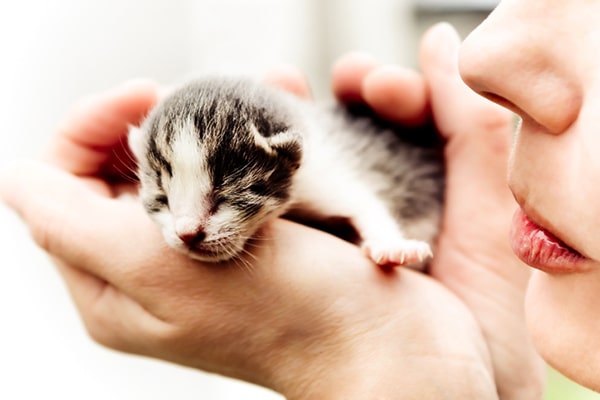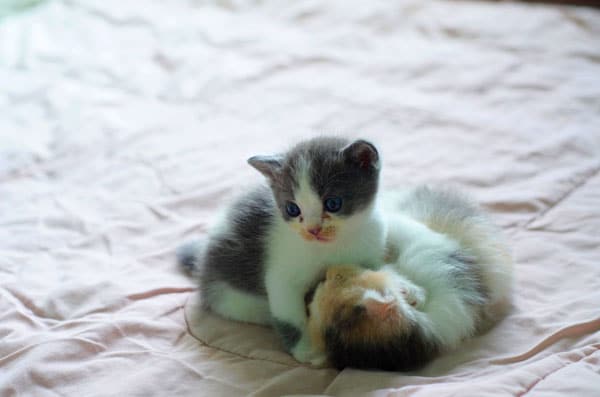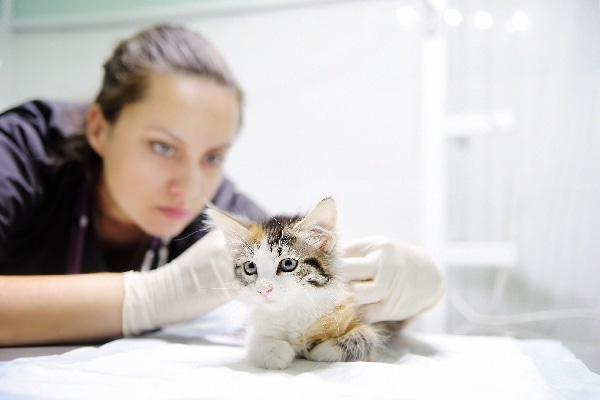Every spring, Mother Nature reveals her regenerative power — and the remarkable fecundity of cats, in the form of millions of newborn kittens. Feral cats are the main source of this bounty. Most kittens born of feral mothers will make wonderful pets if they are properly socialized at an early age. Many of these kittens end up in the care of kindhearted people who foster them after they are orphaned or abandoned. Tragically, as spring turns to summer, Mother Nature reveals her darker side and often breaks the hearts of the kindhearted foster parents who have worked hard to nurture young kittens. A staggering proportion of kittens succumb to fading kitten syndrome before they reach nine weeks of age.
What are the stats?

Fading kitten syndrome is unfortunately very common. Photography by Branislav Ostojic/Thinkstock.
The most recent sources I have seen estimate that even in the best circumstances — in well-managed catteries — 15 percent to 27 percent of kittens die before they are nine weeks old.
It should come as no surprise that foster kittens don’t make the best-case-scenario statistics. Being orphaned or abandoned at an early age, with no prospect of a father in the picture under any circumstances, hardly gives an individual a leg up in life. Mortality among litters of foster kittens can be devastatingly high. It is not uncommon for death rates to reach 100 percent.
Why does fading kitten syndrome happen?
And, more important, what can you do to prevent fading kitten syndrome?
The word “syndrome” should be a tip off. Fading kitten syndrome is not a single entity; rather, it describes a large number of problems and conditions that can cause death in young kittens.
Related: 7 Things to Do If You Find an Orphaned Kitten
Most kittens who die from fading kitten syndrome appear to get sick and die suddenly. However, with a few exceptions (such as hypothermia and trauma), the problem generally builds gradually but is very difficult to detect until a crisis develops. I am sorry to say that the prognosis for kittens in crisis is poor. Therefore, the key to reducing fatality from fading kitten syndrome is early detection of subtle problems before a crisis occurs.
Causes of fading kitten syndrome

What are the causes of fading kitten syndrome? Photography by by Nokkapood1977 / Shutterstock.
When in crisis, almost all fading kittens exhibit similar symptoms. Profound lethargy, low body temperature, pale gums, low respiratory rate, and failure to root and nurse or eat are nearly universal signs of the syndrome. However, these signs can be caused by a large number of problems.
Inadequate mothering — by the feline mother — is a leading risk factor for fading kitten syndrome. Most foster kittens are subject to this risk factor in the extreme, since they were orphaned or abandoned by their mothers. Even kittens with mothers in the picture may be at risk if the mother is inexperienced, unable to produce sufficient milk, unwilling to let the kittens nurse, stressed, malnourished or, paradoxically, obese.
Trauma and hypothermia are two causes of fading kitten syndrome that truly come on suddenly. Trauma occurs most frequently when a kitten falls from a height or gets crushed. Hypothermia occurs when kittens get separated from one another and the mother in a chilly environment. Note that hypothermia is either a cause or a result of a fading kitten crisis. Almost all fading kittens in crisis will exhibit hypothermia.
Infectious organisms are frequent culprits in fading kitten syndrome. Kittens are at risk of sepsis from bacterial infections. Viral infections with organisms such as feline herpesvirus, calicivirus, panleukopenia, FIV/feline AIDS and feline leukemia virus may trigger the syndrome. Parasitic infestations with roundworms, coccidia or other organisms may trigger crises. Many of these infections are linked to immune system collapse, which is usually associated with a condition called thymus atrophy.
Hereditary defects ranging from heart irregularities to undeveloped immune systems may cause fading kitten syndrome.
Hemolytic anemia is another possible cause of the syndrome. This condition can occur when a kitten has a different blood type than its mother. When the kitten nurses during the first days of its life, it ingests antibodies that attack its blood cells.
Treating fading kittens and preventing crises
Kittens in crisis generally require treatment by veterinarians. The mainstays of treatment are thermal support, fluids, dextrose (sugar), and often antibiotics. If the affected kitten begins to warm and recover, nutritional support and deworming medications may be added. Sadly, the prognosis for kittens in crisis is poor, and many of them do not survive even with treatment.
What are the signs of fading kitten syndrome?
Preventing crises is key to reducing fatality from fading kitten syndrome. The early signs of fading kitten syndrome are subtle but often detectable. Sick kittens may not right themselves when turned on their backs. They may not root and suckle normally. Their eyes may not open at the usual age of five to 14 days. They will often be smaller than their littermates.
Most important, they may not gain weight normally. Healthy kittens should gain 7 to 10 grams per day. Experts recommend that kittens be weighed on a gram scale at least once daily (and many experts recommend weighing twice daily). High-quality gram scales can be purchased at kitchen supply stores, smoke shops (you can guess what purpose gram scales serve for some people) and online.
Kittens who do not gain weight at an appropriate rate should receive extra attention with special focus on feeding. Newborn kittens should be fed formula or milk every two hours. Weaning onto mush can begin at approximately four weeks of age.
A kitten lost to fading kitten syndrome can sometimes be a harbinger of problems for the littermates. A veterinarian should assess the mother and any remaining kittens after any such incident.
A final word on fading kitten syndrome
Although this article is intended for foster parents, I will throw in a few pieces of advice for breeders. Both the sire and dam should be blood typed prior to breeding, and that information should be used to prevent hemolytic anemia. Both should be tested for feline leukemia and FIV. The mother should be fully vaccinated and dewormed prior to breeding. And remember that the milk consumed in the first day or so, called colostrum, is the most important milk the kittens will consume, because it contains antibodies that protect the kittens from disease.
With diligence and early detection, some cases of fading kitten syndrome can be reversed before a crisis develops. However, I am sorry to say that many other cases will not respond to the efforts of even the most involved foster parent. Foster parents, please know that although the loss of a kitten — or even an entire litter of kittens — is heartbreaking, it does not necessarily mean that you have done anything wrong. Please keep up the good work.
Featured Photograph ©SbytovaMN | iStock / Getty Images Plus.
Read Next: Kittens Meowing — How and Why Baby Cats Meow
